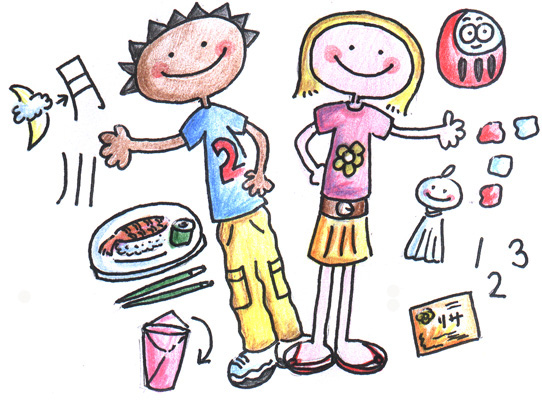Lesson 3
Main (30 minutes)
Give children a copy of their name written using the katakana alphabet (ask your Japanese teacher to help you prepare this). Have children try to copy their own names in Japanese. Are the children able to find the symbols for their names on the katakana chart? How would their name sound in Japanese? You may wish to spend some time practising the sounds of the Japanese syllables with the children.
Children must also be aware that they are not ‘spelling’ their names as they would in English, but are looking for sounds to represent the syllables in their names. It is also important to explain that Japanese doesn’t have all the sounds that English has, so names will sound slightly different.
Children then create their own name badge (see template which can be photocopied), or they can simply be written onto sticky labels. These will then become their shopkeeper name badges when acting in role during the next activity.
Model the following conversation with the Japanese teacher/ dialogue soundfiles:
| A: | すみません。いくらですか | sumimasen. Ikura desu ka |
| Excuse me. How much is it? | ||
| B: | 150 円です。 | hyakugoju en desu. |
| It’s 150 yen. | ||
| A: | ありがとうございます。 | arigato gozaimasu |
| Thank you. |
Note: ‘sumimasen - すみません’ has no real direct translation and can have a slightly different meaning depending on the context it’s used in. In this case it means ‘excuse me’, but can also mean ‘sorry’.
Ask children if they can guess what’s been said? How do they know that a question has been asked? (the addition of ‘ka - か’ at the end of the sentence).
Model the conversation several times and have the children repeat each part.
Now have the children practise the conversation in pairs, using the photos of priced food in the ‘how much?’ presentation as a stimulus. Discuss the food images and talk about the less familiar food items with the children (explanation included on the presentation).
Optional Extra:
Repeat the above conversation using pounds and pence instead of yen.
Remember to emphasise that ‘pound’ is pronounced ‘pondo - ポンド’ and ‘pence’ as
‘pensu - ペンス’. Example:
| A: | すみません。いくらですか | sumimasen. Ikura desu ka |
| Excuse me. How much is it? | ||
| B: | 4 ポンド 99 ペンスです。 | yon pondo kyujukyu pensu desu. |
| It’s £4.99. | ||
| A: | ありがとうございます。 | arigato gozaimasu |
| Thank you. |
Set up a mock shop at the front of the classroom (display various items with price tags – perhaps use the example templates in the worksheets section of this lesson). Pairs of children should be encouraged to come up to the front - one should act as the shopkeeper (wearing the name badge) and the other child should be the customer. Children should demonstrate the conversation and other class members should check that the prices of items are being told correctly.
Optional Extras:
In many Japanese shops, such as department stores, proper etiquette towards the
customers is all-important. Some stores employ staff (mainly women) to bow to customers
as they take the lift for example. This is a sign of respect towards the customer and
also general polite behaviour. For more information on correct bowing techniques and the
subtleties of bowing, see the Culture Notes. Children should be encouraged to practise
bowing to one another - ask the Japanese teacher to model correct bowing techniques.
The following are websites to some of the larger department stores in Japan:
| https://www.itoyokado.co.jp/special/global/en/products/foods/ | (site in English) |
| https://www.takashimaya-global.com/en/ | (site in English) |
| https://www.sogo-seibu.jp/foreign/welcome/ | (site in English) |
(Y5, Y6)
Children could have a go at the code-breaking activity - present the children with the
worksheet accompanying the katakana chart. Pupils must use the katakana chart to
crack the code and work out various different people’s names. Are there any names
they find difficult to decipher? Why? (Remind them of the lack of sounds in Japanese
compared to English). Knowing that fact, is it now easier to work out?
(Y3, 4, 5, 6)
Children could make a plaque of their name (in Japanese), using clay - the design
could then be fired and used for display. Alternatively, a ‘stamp’ of the child’s name
could be made (either using polystyrene which is engraved, or clay to make raised
letters). One thing to remember is that the letters should be written in reverse to
ensure that they print out correctly - tracing paper could be used to make this easier.
